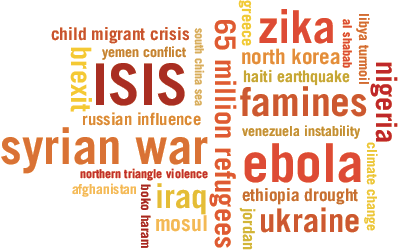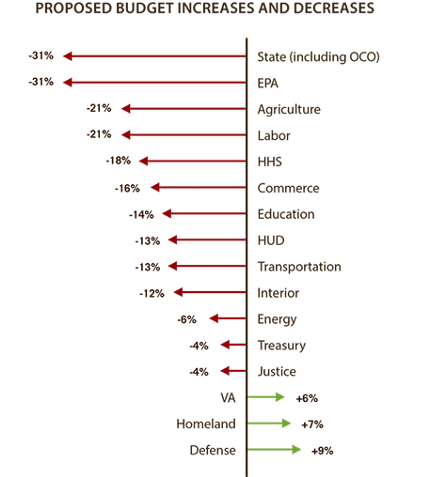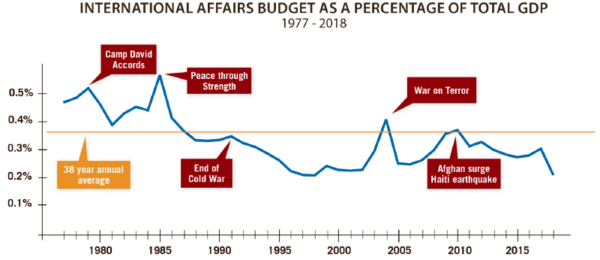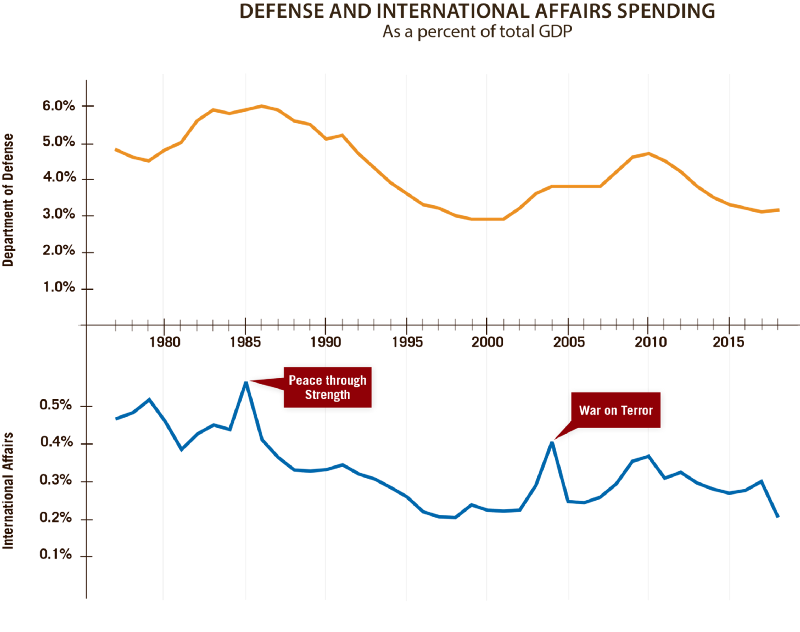
April 14, 2017

In keeping with promises to shrink the federal bureaucracy and with a priority placed on the “deconstruction of the administrative state”, the Administration today released its FY18 “skinny” budget, which includes a proposal to slash the State Department and USAID by 31% from current levels. It would also cut Treasury’s International Programs by 35%. The draconian and disproportionate cuts to these programs — which have long been key pillars of U.S. national security — would take funding levels for development and diplomacy programs back to levels not seen since 9/11.
The budget includes topline agency totals for the Defense and Non-Defense Discretionary (NDD) budgets, but provides little detail related to specific program funding levels. The proposal increases spending for the Department of Defense by $54 billion but makes deep, historic cuts to the NDD budget by the same level.
Specifically, the State Department and other international programs receive the most severe cuts compared to all federal agencies, along with the Environmental Protection Agency. A few details:
The budget includes a total of $37.6 billion for the State Department and USAID, a 31% cut from the FY17 Continuing Resolution (CR). This includes base funding ($25.6 billion) and Overseas Contingency Operations (OCO) funding ($12 billion). If enacted, this would be the lowest level of funding for these programs since FY02 in real (inflation adjusted) terms.
The budget cuts base funding alone by 28% — perpetuating an overreliance on OCO funds (meant to be temporary in nature) to address long-term, enduring challenges.
The budget also includes $1.5 billion for Department of Treasury International Programs, a 35% cut compared to current levels.
Funding levels for sub-cabinet agencies, like the Millennium Challenge Corporation and Peace Corps, are unclear.
Already there is significant pushback against these cuts. Last week, more than 120 retired generals and admirals wrote to congressional leadership saying “now is not the time to retreat” and today, more than 100 conservative faith leaders sent a similar message. In the few hours since the Administration unveiled its proposal, it has been rejected on all fronts — from Freedom Caucus members like Representative Ted Yoho (R-FL) to House State and Foreign Operations Appropriations Subcommittee Chair Representative Hal Rogers (R-KY).
Simply put, cutting one-third of our civilian forces of development and diplomacy at a time of extreme global threats, famines of historic proportions, and a refugee crisis not seen since World War II is unimaginable. USGLC released this statement in response to the Administration’s budget, urging Congress to oppose these cuts and protect level funding for the International Affairs Budget.
While the full details of the Administration’s request will not be made public for several months, here are our major takeaways based on today’s proposal.
1. With Historic Cuts to Non-Defense Discretionary Spending, International Affairs Takes a Severely Disproportionate Cut

The Administration’s budget includes a total of $462 billion for Non-Defense Discretionary (NDD) spending, 10% below FY17. The proposed cut affects almost every non-defense federal agency with the State Department receiving the steepest cut, along with the Environmental Protection Agency. In justifying such a draconian cut, the Administration notes that slashing these programs “free[s] up funding for critical priorities here at home and put[s] America first” even though these programs account for a mere 1% of the federal budget.
2. International Affairs at a Historic Low as Percentage of Gross Domestic Product (GDP)
The deep cuts to development and diplomacy programs proposed in the Administration’s budget would reduce spending on these programs as a percentage of GDP to its lowest level since World War II.
Under President Ronald Reagan’s “peace through strength” credo, funding for the International Affairs Budget reached nearly 0.6% of GDP in the 1980s. Since then, spending has ebbed and flowed as the U.S. has confronted challenges overseas; for instance in the 1990s during a period of relative stability, funding dropped. The Administration’s budget would, however, slash funding for development and diplomacy to approximately 0.2% of GDP at a time when global challenges are on the rise.

3. Proposal Breaks with Decades of Bipartisan Consensus on a Military-Civilian National Security Framework
While there has never been a formal national security budget, since 9/11 there has been a bipartisan consensus that development and diplomacy, alongside defense, are key pillars of U.S. national security. With this consensus, funding for defense and international affairs has largely been seen as part of a national security framework, with proportionate funding ebbing and flowing together as a percentage of GDP.
Just a week after the current Commander of U.S. AFRICOM told Congress that “diplomacy and development are key efforts” in protecting and promoting U.S. national security interests, this budget proposal marks a dramatic break in funding decisions related to our national security framework.

4. Global Health Prioritized, Mixed Results for Development and Humanitarian Programs
While specific funding levels are not included, the budget seemingly prioritizes global health, where there is a long history of bipartisan U.S. leadership. The budget would “provide sufficient resources” to fulfill the U.S. commitment to Gavi, the Vaccine Alliance, “maintain current commitments and all current patient levels on HIV/AIDS treatment” under PEPFAR and maintain funding for malaria programs, and meet the U.S. commitment to the Global Fund to Fight AIDS, TB, and Malaria. Inclusion of this funding appears to contradict recent rumors about more dramatic cuts; although there are no indications as to funding levels for other global health programs, such as maternal and child health.
Economic development programs, however, are “refocused” to countries of “greatest strategic importance to the U.S.” and the proposal notes the importance of ensuring effectiveness of investments “by rightsizing funding across countries and sectors.” With so little detail available, it will be important to watch how the Administration seeks to “refocus” these programs in its more detailed budget, including development assistance.
The budget notes “significant funding” for humanitarian assistance “including food aid, disaster, and refugee assistance” but leaves open the question of whether the U.S. will maintain its leadership role, noting that “the rest of the world” will be asked to “pay their fair share”. The budget also argues that the Emergency Refugee and Migration Assistance account is duplicative and calls for its elimination along with the McGovern-Dole program. With four current famines impacting 20 million people, this will likely raise significant concerns on Capitol Hill.
5. Lever of U.S. Influence Cut or Eliminated
Some of the harshest language in the proposal is used to question the impact of multilateral organizations. Without providing specific funding levels, the budget “reduces funding to the UN and affiliated agencies, including UN peacekeeping and other international organizations” and calls for organizations to rein in costs and prioritize burden-sharing among members. Further, funding for multilateral development banks, including the World Bank, would be significantly reduced.
The proposal also calls for the elimination of several agencies and programs that have been critical in advancing U.S. economic, security, and humanitarian interests overseas. A total of 19 agencies across the government were eliminated, five of which are funded through the International Affairs Budget, although Members of Congress on both sides of the aisle are already rejecting the elimination of these agencies.
6. Budget Foreshadows Major Restructuring of Foreign Assistance
Earlier this week, the Administration released an Executive Order that calls for the Office of Management and Budget to reorganize the federal government and merge departments and programs that are found to be “duplicative.” While the Executive Order does not specifically mention foreign assistance, the budget proposal states that the Administration “recognizes the need for State and USAID to pursue greater efficiencies through organization and consolidation in order to enable effective diplomacy and development.”
While it is unclear how the Administration intends to pursue this reorganization, Secretary of State Tillerson has been tapped to lead the effort, saying, “I’m confident that with the input of the men and women of the State Department we are going to construct a way forward that allows us to be much more effective, much more efficient and be able to do a lot with fewer dollars.”
7. Back to the Cold War
From the start, the Administration’s public posture has singled out the State Department and USAID (along with EPA) for cuts. In framing the budget, OMB Director Mulvaney argued that it is a “hard power budget, not a soft power budget.” This debate between the use of hard and soft power is a relic of the Cold War that ended long ago. Since then, and especially after 9/11, our national security strategies have called for the use of smart power — development and diplomacy, alongside defense — to keep America safe.
This budget harkens back to the Cold War by failing to take into account the myriad global challenges we face today, none of which existed a decade ago.

As foreign policy and national security experts including former Secretary of Defense Bob Gates and current Secretary of Defense Jim Mattis have repeatedly observed, we cannot address today’s threats through hard power alone.
Congress has been quick to reject the Administration’s proposed cuts, with strong statements from both Democratic and Republican lawmakers about the dire consequences of such deep and disproportionate cuts to the State Department and USAID.
“General Mattis, ‘Mad Dog’ Mattis, says that if we slash State Department funding, he’s going to have to order a lot more ammunition. And over 100 admirals and generals — retired admirals and generals — have said essentially the same thing. So I’m absolutely shocked at the Administration’s puny request…” — Representative Hal Rogers (R-KY)
“I am very concerned that deep cuts to our diplomacy will hurt efforts to combat terrorism, distribute critical humanitarian aid, and promote opportunities for American workers” — Rep. Ed Royce (R-CA)
“Former President Bush’s comment, which I’ve quoted many times, is as true as ever: ‘Defense, diplomacy, and development are equal legs of a stool of American foreign policy.’ Yet, dramatic reductions in the President’s proposed budget for the Function 150 account would undermine that delicate balance with the impacts of deep, ill-advised cuts.” — Representative Nita Lowey (D-NY)
“It’s dead on arrival, it’s not going to happen, it would be a disaster… This budget destroys soft power, it puts our diplomats at risk and it’s going nowhere.” — Senator Lindsey Graham (R-SC)
“Slashing foreign assistance would be foolhardy, weakening our leadership and emboldening our adversaries.” — Senator Patrick Leahy (D-VT)
“I think foreign aid is pretty important myself… There are some pretty important programs that keep America open for business and that are vital to our national security.” — Representative Rodney Frelinghuysen (R-NJ)
“I am deeply disappointed and dismayed to find out that despite the concerns raised by bipartisan Members of Congress and even by his own Secretary of State, President Trump appears determined to gut U.S. national security by slashing the State Department and USAID.” — Senator Ben Cardin (D-MD)
“At a time when American leadership is needed more than ever, we must continue to invest in the International affairs budget.” — Representative Ted Yoho (R-FL)
“If we slash funding for diplomacy and development, we’re telling our service members and the American people, we’ll take our chances down the road — even if that may mean a much steeper cost in terms of American blood and American treasure.” — Representative Elliot Engel (D-NY)
Ultimately, the U.S. Constitution gives Congress the power of the purse. This means that spending decisions — including topline levels and funding for programs — will be determined and finalized through the FY18 appropriations process.
Before that can happen, Congress needs to close out its work on FY17 spending bills, with a short-term CR set to expire on April 28th. As part of the discussion to finalize FY17, the Administration proposed this week an $18 billion cut to Non-Defense Discretionary spending. If applied across the board, this would amount to a 3% cut to international affairs programs. Of course, Congress will decide the final spending levels for FY17.
With so many competing priorities, is unclear when Congress will move forward on its FY18 budget and appropriations process. Historically, the House and Senate Budget Committees would first move their proposed budget resolutions before Appropriators begin work on the spending bills. However, with final decisions on FY17 still pending and Congress focused on other issues, the FY18 budget process may see significant delays.
One thing is certain — continued strong support from lawmakers on both sides of the aisle will be critical to protecting the International Affairs Budget in FY18.